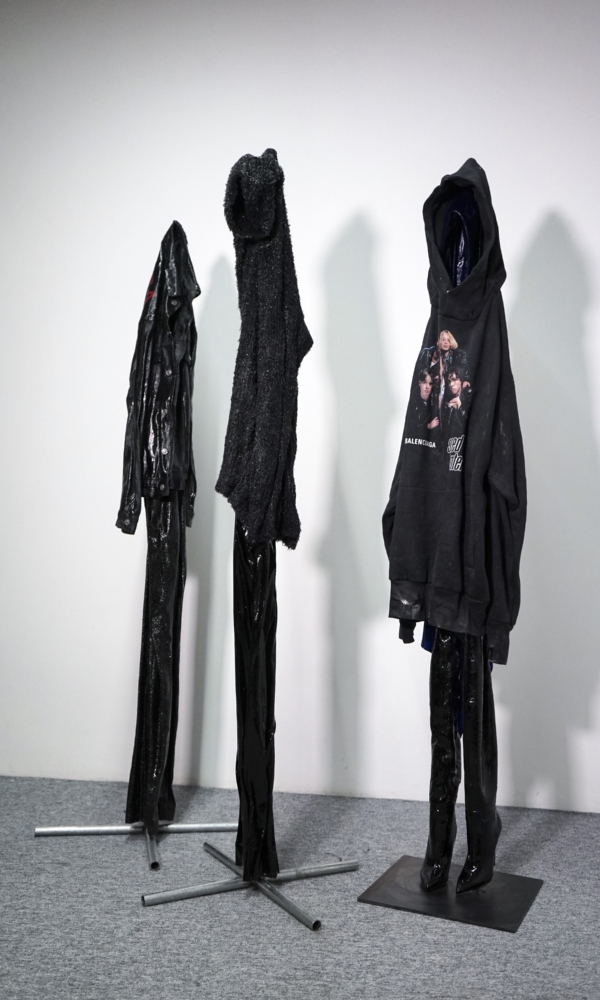For Artist Tobias Spichtig, Shopping is a Way of Sculpting

Ghosts, Balenciaga, 2019. Image courtesy the artist.
Should a luxury store design offer shoppers an idealized vision of the human experience? The Swiss artist Tobias Spichtig doesn’t think so. Spichtig has taken his series of “Gheist” sculptures—ethereally thin, human-like figures that at first glance may appear to be some sort of demented mannequin—to Balenciaga, a perfectly dystopian complement to the stores’ new design. With tubular aluminum railing, suede couches, and cloudscapes projected onto the ceilings, the new stores carry the aura of a movie set in which a group of models flee a climate change-destroyed earth in a minimalist escape pod.
This strain of Balenciaga nihilism, designed by Demna Gvasalia and Niklas Bildstein Zaar, can be experienced at the store’s new flagship on Madison Avenue, the first to include a sculpture by Spichtig. Aside from the flagship, Spichtig’s sculptures will also be featured in new stores in Paris and London, among other cities. To celebrate Spichtig’s love of the macabre (and luxury goods), Interview spoke with Spichtig over the phone from his studio in Berlin about his sculptures, the art of shopping, and the Grim Reaper.
———
PATRICK MCGRAW: You once told me that you starting making the ghost sculptures because you felt lonely and wanted to fill your apartment with friends.
TOBIAS SPICHTIG: Yeah, I was living on my own and thought it would be nice to have people around all the time. So I took these clothes that people had left in my apartment after a New Years’ party. You know that feeling you get when there are all these clothes lying around, that they’re kind of looking at you? Or you think for a second, ‘Oh shit, that’s a person?’ So I made the first one with these clothes and kept making more.
MCGRAW: Did you throw more parties to get more clothes?
SPICHTIG: I eventually started going to thrift stores to get more clothes, so the sculptures were also a bit of an excuse to go shopping. I had always wanted to be into fashion but I didn’t really have money. So I told myself I could buy clothes because I’m making works out of them.
MCGRAW: So if clothes are the artist’s materials, then buying clothes is like sculpting…
SPICHTIG: Well, if you’re doing figurative sculpture, and you want to make a body, the proportions are already built into the clothes. Clothes are also empty, and I wanted them to stay that way. When I started making them, there were mannequins in every museum show. But the ghosts are kind of the opposite of mannequins. They’re just empty clothes. I wanted them to be ghostly, or like the Grim Reaper.

Ghosts, Balenciaga, 2019. Image courtesy the artist.
MCGRAW: Did you shop for a specific type of clothes?
SPICHTIG: Mostly clothes that I would wear. Then there’s certain things you can’t buy. I mean if you buy shorts, then it’s going to look like somebody cut their legs off, you know? So it’s kind of specific.
MCGRAW: And you started pouring resin all over them.
SPICHTIG: My dad built airplanes, and a lot of the parts they used were with this type of resin that you mixed with fiberglass, like for sailing boats or surfboards. I called up this company that my dad used to work with. The best resin to use with cotton is the same resin they use with sports equipment and airplanes. So with the ghosts, I’m drenching resin on clothes, whereas with planes, you would drench it on fiberglass.
MCGRAW: They’ve traveled such a long distance from being objects in your living room to being in luxury retail stores. Do you think that’s changed the sculptures?
SPICHTIG: In a way, it’s the success story of the ghosts. First they were from a thrift store, and now they’re luxury clothes. But to me, they haven’t changed at all.
MCGRAW: It almost turns the ghosts into one big performance. Once they were poor, and now they’ve become rich.

Photo by Annik Wetter. Courtesy Balenciaga.
SPICHTIG: But they’re still doing the same act. They’re just annoying and standing around and nobody knows what they’re there for. In a strange way, they’re unspectacular. Because they’re empty. They’re really empty. I like that.
MCGRAW: How do you think the average shopper is going to interact with the sculptures?
SPICHTIG: I think the average shopper would look at them the same way they might look at any other sculpture, person or clothes. Some people might not even notice them.
MCGRAW: I feel like that would upset most artists.
SPICHTIG: Well of course they would notice them, but the ghosts are like an object, but also nothing…But because they’re nothing, they become more than nothing. People fill them with love because they can’t wear them.
MCGRAW: What does it say to show the same works in a store after a gallery? Is a gallery just a store anyway?
SPICHTIG: Yeah, except in a store you can’t buy the sculptures, and in a gallery you can’t buy the clothes a gallerist is wearing. But it’s the old question of money and art. And I don’t think you can have an opinion on money and art because that’s like having an opinion on water.
MCGRAW: Is there a relationship between the fashion of your sculptures and your paintings? They often include things like models, clothes, or sunglasses etc.

Tobias Spitchtig, Die vier Jahreszeiten, 2019. Courtesy the artist.
SPICHTIG: Yeah, it’s just what’s around. It’s what people do, and what they wear. With the sunglasses you’re not sure if the painting is looking at you, or you’re looking at the painting. My neighbor also has an amazing sunglasses collection. But the painting could just as easily be a flower, but a flower doesn’t look at you.
MCGRAW: Do you believe in ghosts?
SPICHTIG: There are all these chapels around where I grew up that are from medieval times, and they all had these bone walls and sculptures of death and monks and so on. All of these sculptures looked like ghosts and they had this crazy presence that came from an emptiness that they had. Not in a scary way, but more in an elegant way. They were also kind of funny actually. So I wanted to recreate that presence, only with sports clothes.
MCGRAW: Humor plays a big part in your work, although I have trouble identifying it directly. It’s just kind of there…
SPICHTIG: Well, whenever I try to be serious, people think it’s funny. Serious things are always funny.
MCGRAW: So the Grim Reaper is like a comedian.
SPICHTIG: If you stand on a stage, you’re already funny. If you really stand for something, it’s always going to be comical. And of course, the Grim Reaper is the last one standing.






